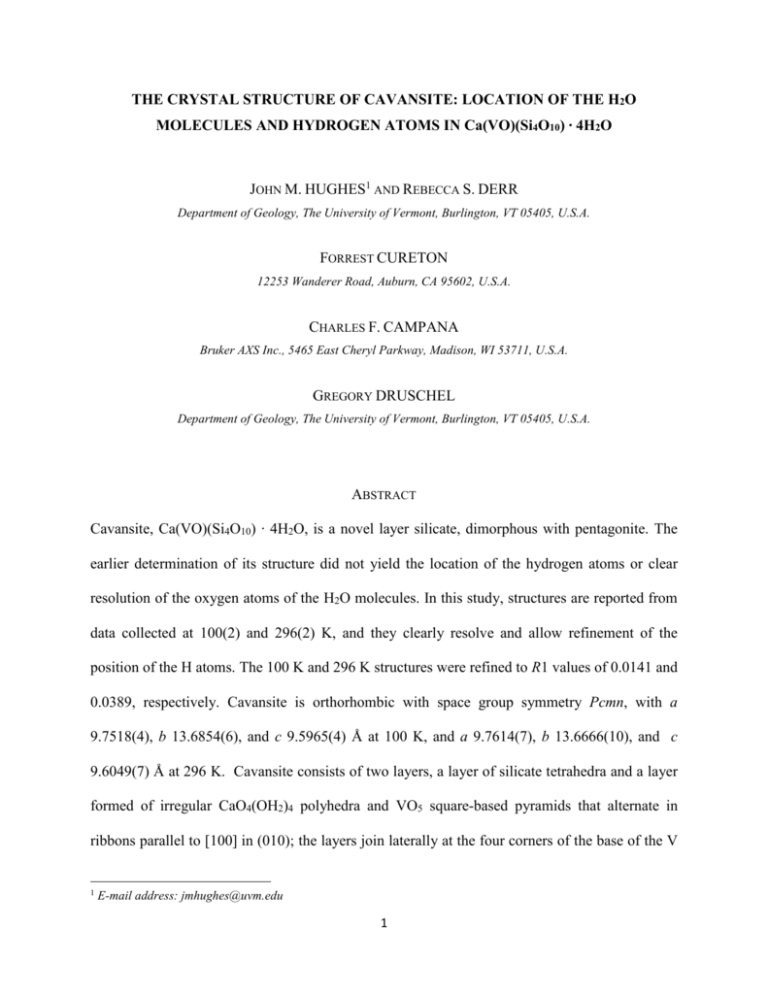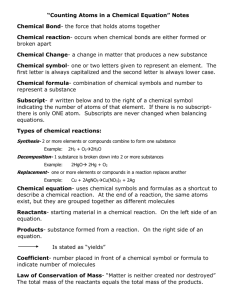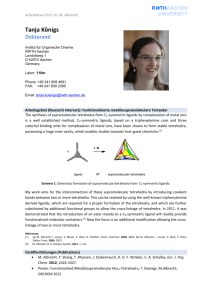THE CRYSTAL STRUCTURE OF CAVANSITE
advertisement

THE CRYSTAL STRUCTURE OF CAVANSITE: LOCATION OF THE H2O MOLECULES AND HYDROGEN ATOMS IN Ca(VO)(Si4O10) ∙ 4H2O JOHN M. HUGHES1 AND REBECCA S. DERR Department of Geology, The University of Vermont, Burlington, VT 05405, U.S.A. FORREST CURETON 12253 Wanderer Road, Auburn, CA 95602, U.S.A. CHARLES F. CAMPANA Bruker AXS Inc., 5465 East Cheryl Parkway, Madison, WI 53711, U.S.A. GREGORY DRUSCHEL Department of Geology, The University of Vermont, Burlington, VT 05405, U.S.A. ABSTRACT Cavansite, Ca(VO)(Si4O10) ∙ 4H2O, is a novel layer silicate, dimorphous with pentagonite. The earlier determination of its structure did not yield the location of the hydrogen atoms or clear resolution of the oxygen atoms of the H2O molecules. In this study, structures are reported from data collected at 100(2) and 296(2) K, and they clearly resolve and allow refinement of the position of the H atoms. The 100 K and 296 K structures were refined to R1 values of 0.0141 and 0.0389, respectively. Cavansite is orthorhombic with space group symmetry Pcmn, with a 9.7518(4), b 13.6854(6), and c 9.5965(4) Å at 100 K, and a 9.7614(7), b 13.6666(10), and c 9.6049(7) Å at 296 K. Cavansite consists of two layers, a layer of silicate tetrahedra and a layer formed of irregular CaO4(OH2)4 polyhedra and VO5 square-based pyramids that alternate in ribbons parallel to [100] in (010); the layers join laterally at the four corners of the base of the V 1 E-mail address: jmhughes@uvm.edu 1 pyramid. The silicate layer consists of four- and eight-membered rings of silicate tetrahedra with apices pointing along [010] or [01̅0]. The four oxygen atoms in the Ca polyhedron that are not linked to the V square-based pyramids are part of H2O molecules. Adjacent ribbons in (010) are linked by hydrogen bonding. Keywords: cavansite, layer silicate, vanadate, crystal structure, India. SOMMAIRE Mots-clés: 2 INTRODUCTION Cavansite, Ca(VO)(Si4O10) ∙ 4H2O, is a novel layer silicate, dimorphous with pentagonite. The general nature of the atomic arrangement of cavansite was described by Evans (1973), but the poor material from Malheur County, Oregon, used in his study and the nature of the extant diffractometers precluded a detailed refinement of the structure; hydrogen atoms were not located, and the locations of the oxygen atoms of the H2O molecules were poorly resolved in the refinement with R = 0.109. A subsequent discovery of cavansite of exceptional quality from Pune, India, allows us to describe the details of the atomic arrangement of this rare mineral, including location of the H2O molecules and the hydrogen atoms. We here report the results of structure refinements at 100(2) and 296(2) K. As described by Evans (1973), the cavansite atomic arrangement consists of sheets of SiO4 tetrahedra that join to form a network of four and eight-member rings in (010). The sheets are separated by layers formed of ribbons of VO5 square-based pyramids and irregular CaO7 polyhedra. We expand upon that description, provide high-quality refinements of the structure and report the location of the H atoms. CRYSTAL STRUCTURE Experimental A blue-green, gem-quality crystal of cavansite from Pune, India, was isolated for our structure study. Chemical data were gathered on a JEOL 6060 Scanning Electron Microscope with an Oxford Instruments INCA 50 mm2 XMAX energy dispersive spectrometer. The only 3 elements detected in energy-dispersive analyses on ten spots were Ca, V, Si and O. A crystal of approximate dimensions 0.21 x 0.24 x 0.37 mm was used for the X-ray structure analysis. The X-ray intensity data were measured on a Bruker APEX II CCD system equipped with a Triumph curved crystal monochromater and a Mo fine-focus tube. The structure was solved and refined using the Bruker SHELXTL Software Package (Sheldrick 2008), with anisotropic full-matrix least-squares refinement on F2. In the 100 K refinement, the H atoms were located in differenceFourier maps, and their positions and isotropic displacement parameters were refined. In the 296 K refinement, the positions of the H atoms were constrained (AFIX 3) with tetrahedral H-O-H angles. Table 1 contains details of data collection and the refinement results, and Table 2 offers the coordinates and equivalent isotropic displacement parameters of the atoms in cavansite. Table 3 (on deposit) lists the anisotropic displacement parameters for the non-hydrogen atoms in cavansite, and Table 4 contains selected bond distances and bond-valence sums for atoms in cavansite. Table 5 (on deposit) contains observed and calculated structure-factors for the two refinements of the cavansite structure. Copies of Tables 3 and 5 and CIF files are available from the Depository of Unpublished Data on the MAC website [document Cavansite CM50_???]. Description of the structure We describe cavansite as a layer silicate structure. The atomic arrangement of cavansite is formed of two alternating layers, a silicate layer and a vanadium-calcium layer. The silicate layer consists of tetrahedra that link three bridging oxygen atoms in (010); the tetrahedra are oriented with tetrahedron apices pointing along [010] or [01̅0]. The vanadium-calcium layer is formed of [001] chains of alternating V4+O5 square based pyramids and irregular CaO4(OH2)4 polyhedra. Rinaldi et al. (1975) noted that cavansite can be considered a framework structure 4 consisting of silicate layers that are connected along b by V4+ square-based pyramids, yielding a framework composition of [(VO)(Si4O10)]2-. The silicate layer The silicate layer in cavansite consists of Si1 and Si2 tetrahedra that join together to form four-membered rings of tetrahedra, each with two Si1 and two Si2 tetrahedra (Fig. 1). Each tetrahedron links two of its oxygen atoms with adjacent members of the ring, and a third oxygen atom with a tetrahedron of an adjacent ring, forming a two-dimensional (010) sheet of tetrahedra. Throughout the four-membered ring and sheet, the tetrahedra alternate in a UUDD manner (Smith 1978), with each Si1 tetrahedron linking in (010) to three Si2 tetrahedra, and each Si2 tetrahedron linking to three Si1 tetrahedra in (010); nowhere does a tetrahedron link to a like tetrahedron. The four-membered rings in cavansite link together to form eight-membered rings (Fig. 1). The eight-membered rings have been compared to the eight-membered rings in the zeolite gismondine (Rinaldi et al. 1975). However, in gismondine the eight-membered rings are nearly circular (axial ratio = 1.1; Rinaldi et al. 1975), whereas in cavansite the rings are elliptical in nature, with an axial ratio of 1.75 (this work). Rinaldi et al. (1975) determined the crystal structure of dehydrated cavansite in order to evaluate the zeolitic properties of the tetrahedral layer. They noted that the eight-membered rings in cavansite and the dehydrated phase possess the UUUUDDDD tetrahedral sequence characteristic of gismondine. They noted that, in gismondine, such a framework can undergo adjustments in order to accommodate different kinds and quantities of sorbates in the structure. Rinaldi et al. (1975) suggested that dehydrated cavansite, without the obscuring H2O molecules 5 in the hydrated structure, may possess catalytic activities suitable for uses in molecular sieve technology. The vanadium-calcium layer The vanadium-calcium layer consists of alternatingV4+O5 square-based pyramids and irregular CaO4(OH2)4 polyhedra that are linked together to form [100] ribbons in (010) (Fig. 2); the polyhedra alternate within the ribbon. Each VO5 square-based pyramid links through two of its basal oxygen atoms to the neighboring Ca polyhedron on either side; thus the four basal oxygen atoms are shared with adjacent Ca polyhedra. The apical oxygen of the square-based pyramid does not bond to any other cation except hydrogen, but links adjacent chains through hydrogen bonding with atom H9a. The four oxygen atoms of the Ca polyhedra that are not linked with the V4+O5 square based pyramids are part of H2O molecules. The vanadyl (VO6) 2+ group of the square-based pyramid has the typical short vanadyl bond, 1.6035(4) Å at 100 K and 1.5893(14) Å at 296 K. The small difference in vanadyl bond distance and thus vanadyl bond valence at the two temperatures cannot be explained by increased hydrogen bonding received from H9a at lower temperature, as the hydrogen bond distance to O6 at 100 K is 2.19 Å, whereas at 296 K the distance is 2.09 Å. Linkage of the Two Layers The silicate layer bonds laterally with the vanadium-calcium layer to complete the atomic arrangement. An oxygen atom, either O1 or O2, at each of the four corners of the base of the 6 VO5 square-based pyramid is shared by the calcium polyhedron and a silicate tetrahedron (Fig. 3). In the calcium polyhedra, these oxygen atoms are the only ones not forming H2O molecules. Atoms O1 and O2 are the apical oxygen atoms of Si1 and Si2, respectively, and this is where the two different layers bond together. One Si1 and one Si2 tetrahedron link to two corners on one side on the base of the VO5 square-based pyramid, and a Si1 and a Si2 tetrahedron from another silicate layer link to the remaining two corners of the base of the pyramid on the other side, with O2 and O1 atoms diagonally across the base of the pyramid from each other. Evans (1973) conjectured on hydrogen bonding in the cavansite structure, although he was unable to locate the H atoms. He suggested that hydrogen bonding caused the close approach of O-H…O in any H2O…O interaction with an O-O distance less than 3.00Å. In this study, we located the H atoms and can define a hydrogen bond as an approach of O-H…O wherein the donor-acceptor H-O distance is less than 2.20 Å (Hughes et al. 2001). With this definition that recognizes the role of the H atom, there are two hydrogen bonds in cavansite. The O6-H9a interaction links adjacent ribbons in the calcium-vanadium layer (Fig. 2), and the O5H7b interaction further links the layer of tetrahedra and the calcium-vanadium layer. ACKNOWLEDGMENTS The authors gratefully acknowledge Editor-in-Chief Robert F. Martin for his longstanding contributions to mineralogy through his service to The Canadian Mineralogist. The manuscript was improved by reviews by Michael Schindler and William Wise. This study was funded, in part, by grant NSF-MRI 1039436 from the National Science Foundation to JMH. 7 8 REFERENCES BRESE, N.E. & O’KEEFFE, M. (1991) Bond-valence parameters for solids. Acta Cryst., B47, 192197. EVANS, H.T., JR. (1973) The crystal structures of cavansite and pentagonite. Am. Mineral. 58, 412-424. HUGHES, J.M., CURETON, F.E., MARTY, J., GAULT, R.A., GUNTER, M.E., CAMPANA, C.F., RAKOVAN, J., SOMMER, A., & BRUESEKE, M.E. (2001) Dickthomssenite, Mg(V2O6) ∙ 7H2O, a new mineral species from the Firefly-Pigmay mine, Utah: Descriptive mineralogy and arrangement of atoms. Can. Mineral. 39, 1691-1700. RINALDI, R., PLUTH, J.J., & SMITH, J.V. (1975) Crystal structure of dehydrated cavansite at 220° C. Acta Cryst. B31, 1598-1602. SHELDRICK, G.M. (2008) A short history of SHELX. Acta Cryst. A64, 112–122. SMITH, J.V. (1978) Enumeration of 4-connected 3-dimensional nets and classification of framework silicates, II: Perpendicular and near-perpendicular linkages from 4.82, 3.122, and 4.6.12 nets. Am. Mineral. 63, 960-969. 9 TABLE 1. DATA COLLECTION AND STRUCTURE REFINEMENT DETAILS FOR CAVANSITE. WHERE THE DATA DIFFER, 100K DATA ARE ON FIRST LINE, 296K DATA ON SECOND LINE. Diffractometer X-ray radiation Temperature Structural Formula Space group Unit cell dimensions Z V Absorption coefficient F(000) Crystal size range Index ranges Reflections collected / unique Reflections with Fo > 4F Max. and min. transmission Refinement method Parameters refined GoF Final R indices [I > 2(I)] R indices (all data) Largest diff. peak / hole Bruker APEX II CCD MoK ( = 0.71073 Å) 100(2) K 296(2) K Ca(VO)(Si4O10) ∙ 4H2O Pcmn a = 9.7518(4) Å a = 9.7614(7) Å b = 13.6854(6) Å b = 13.6666(10) Å c = 9.5965(4) Å c = 9.6049(7) Å 4 1280.72(9) Å3 1281.34(16) Å3 1.631 mm-1 908 0.21 x 0.24 x 0.37 mm 2.56 to 52.16° 2.56 to 47.83° -21≤h≤21, -29≤k≤30, -19≤ℓ≤21 -20≤h≤20, -28≤k≤28, -18≤ℓ≤20 98017 / 7499 [Rint = 0.0177] 91723 / 6242 [Rint = 0.0445] 7,130 1,928 0.7257 and 0.5867 0.7258 and 0.5868 Full-matrix least-squares on F2 121 103 1.133 1.094 R1 = 0.0141, wR2 = 0.0341 R1 = 0.0367, wR2 = 0.0987 R1 = 0.0154, wR2 = 0.0347 R1 = 0.0389, wR2 = 0.1000 1.605/ -0.827 eÅ-3 1.826/ -1.587 eÅ-3 10 TABLE 2. ATOMIC COORDINATES AND EQUIVALENT ISOTROPIC ATOMIC DISPLACEMENT PARAMETERS (Å2) FOR CAVANSITE AT 100 K (FIRST ROW) AND 296 K (SECOND ROW). Atom x/a y/b z/c U(eq) V 0.403461(6) 0.40796(2) 1/4 1/4 0.527127(6) 0.52610(2) 0.00441(10) 0.00958(4) Ca 0.081188(8) 0.08632(3) 1/4 1/4 0.384158(7) 0.38270(3) 0.00538(10) 0.01177(4) Si1 0.092905(8) 0.09326(3) 0.033726(6) 0.03399(2) 0.184986(8) 0.18476(3) 0.00382(10) 0.00784(4) Si2 0.314548(8) 0.31501(3) 0.043079(6) 0.04327(19) 0.394816(8) 0.39474(3) 0.00367(10) 0.00758(4) O1 0.08484(2) 0.08426(8) 0.150457(15) 0.15083(5) 0.17923(2) 0.17913(7) 0.00609(2) 0.01217(10) O2 0.29352(2) 0.29503(9) 0.157711(15) 0.15790(5) 0.41364(2) 0.41533(8) 0.00677(3) 0.01367(11) O3 0.44562(2) 0.44570(8) 0.019683(18) 0.01877(7) 0.29592(2) 0.29636(8) 0.00688(3) 0.01436(11) O4 0.16568(2) 0.16543(8) 0.989344(16) 0.98960(5) 0.04467(2) 0.04456(7) 0.00605(2) 0.01233(10) O5 0.18145(2) 0.18173(8) 0.995496(15) 0.99676(6) 0.31844(2) 0.31835(7) 0.00555(2) 0.01163(10) O6 0.55289(4) 0.55529(16) 1/4 1/4 0.45740(4) 0.45570(17) 0.01021(4) 0.0235(2) OW7 0.94626(4) 0.9388(3) 0.11855(3) 0.12314(18) 0.47063(3) 0.4635(2) 0.01585(5) 0.0654(7) H7a -0.1211(12) -0.1294 0.1117(9) 0.1168 0.4266(12) 0.4201 0.034(3) 0.078 H7b -0.0728(12) -0.0801 0.0887(8) 0.0936 0.5460(12) 0.5387 0.031(3) 0.078 OW8 0.13254(5) 0.1128(4) 1/4 1/4 0.63927(4) 0.6393(2) 0.01471(6) 0.0541(8) 11 H8a 0.1283(14) 0.1083 0.2993(9) 0.2993 0.6935(13) 0.6932 0.047(4) 0.065 OW9 0.81138(7) 0.8098(13) 1/4 1/4 0.28676(7) 0.295(2) 0.02668(11) 0.396(13) H9a -0.2705(18) -0.2717 1/4 1/4 0.3162(17) 0.3235 0.033(4) 0.475 H9b -0.202(2) -0.2046 1/4 1/4 0.197(2) 0.2052 0.057(6) 0.475 ____________________________________________________________________________________________________________ 12 TABLE 4. SELECTED BOND DISTANCES (Å) AND BOND-VALENCE VALUES (vu) IN 100 K AND 296 K CAVANSITE. BOND VALENCE PARAMETERS FROM BRESE AND O’KEEFFE (1991). __________________________________________________________________________________ 100 K V- Distance O6 O2 (x2) O1 (x2) Mean, Sum: 1.6035(4) 1.9826(2) 1.9998(2) 1.9137 CaOW7 (x2) O1 (x2) O2 (x2) OW8 OW9 Mean, Sum: 296K Bond Valence V- Distance Bond Valence 1.63 0.58 0.56 3.91 O6 O2 (x2) O1 (x2) Mean, Sum: 1.5893(14) 1.9828(8) 2.0008(7) 1.9113 1.69 0.58 0.56 3.97 2.3782(3) 2.3926(2) 2.4419(2) 2.4989(4) 2.7922(7) 2.4646 0.33 0.32 0.28 0.24 0.11 2.21 CaO1 (x2) OW7(x2) O2 (x2) OW8 OW9 Mean, Sum: 2.3791(8) 2.3836(17) 2.4153(8) 2.479(2) 2.829(17) 2.4579 0.33 0.32 0.30 0.25 0.10 2.25 Si1O1 O3 O5 O4 Mean, Sum: 1.6004(2) 1.6220(2) 1.6308(2) 1.6388(2) 1.623 1.07 1.01 0.98 0.96 4.02 Si1O1 O3 O5 O4 Mean, Sum: 1.6002(8) 1.6210(8) 1.6281(7) 1.6364(7) 1.6214 1.07 1.01 0.99 0.97 4.04 Si2O2 O3 O5 O4 Mean, Sum: 1.5924(2) 1.6239(2) 1.6266(2) 1.6267(2) 1.6174 1.09 1.00 0.99 0.99 4.07 Si2O2 O3 O5 O4 Mean, Sum: 1.5910(8) 1.6225(8) 1.6233(7) 1.6264(7) 1.6158 1.09 1.00 1.00 0.99 4.08 BOND-VALENCE SUMS FOR OXYGEN ATOMS NOT FORMING WATER MOLECULES (HYDROGEN BONDS NOT INCLUDED): O1: 1.95 O4: 1.95 O1: 1.96 O4: 1.96 O2: 1.95 O5: 1.97 O2: 1.97 O5: 1.99 O3: 2.01 O6: 1.63 O3: 2.01 O6: 1.69 13 FIG. 1. The silicate layer of the atomic arrangement in cavansite. Gray polyhedra represent Si1 tetrahedra, which have apical oxgen atoms, O1, whereas orange represent Si2 tetrahedra with apical oxygen atoms, O2. The unit cell is shown. a b c 14 FIG. 2. The vanadium-calcium layer containing alternatingV4+O5 square-based pyramids and irregular CaO4(OH2)4 polyhedra. The dashed lines indicate hydrogen bonding between O6 and H9a. Note only one side of the VO5 square-based pyramid is seen. c a b 15 FIG 3. The Si and V-Ca layers join laterally to complete the crystal structure of cavansite. The colors of the tetrahedra are as in Figure 1. 16 TABLE 3. ANISOTROPIC ATOMIC DISPLACEMENT PARAMETERS (Å2) FOR CAVANSITE. (A): 100K, (B): 296K. (FOR DEPOSIT) (A) U11 U22 U33 U23 U13 U12 V 0.00536(2) 0.00428(2) 0.00359(2) 0 -0.00041(10) 0 Ca 0.00685(2) 0.00501(2) 0.00429(2) 0 0.00029(2) 0 Si1 0.00389(2) 0.00451(2) 0.00308(2) 0.00004(2) -0.00019(2) -0.00022(2) Si2 0.00362(2) 0.00399(2) 0.00340(2) -0.00018(2) -0.00039(2) 0.00021(2) O1 0.00868(6) 0.00475(6) 0.00485(5) 0.00030(4) 0.00045(5) 0.00041(5) O2 0.00806(6) 0.00438(6) 0.00787(6) -0.00105(5) -0.00270(5) 0.00068(5) O3 0.00450(6) 0.01036(7) 0.00580(6) 0.00046(5) 0.00080(4) 0.00194(5) O4 0.00818(6) 0.00609(6) 0.00387(5) 0.00030(4) 0.00143(5) 0.00064(5) O5 0.00526(6) 0.00640(6) 0.00499(5) 0.00064(4) -0.00177(4) -0.00088(5) O6 0.00765(10) 0.01258(12) 0.01040(11) 0 0.00238(8) 0 OW7 0.01715(11) 0.01788(11) 0.01251(9) 0.00285(8) 0.00119(8) -0.00909(9) OW8 OW9 0.02600(19) 0.0203(2) 0.01144(12) 0.0396(3) 0.00668(10) 0.0201(2) 0 0 -0.00245(11) 0.00047(17) 0 0 17 (B) U11 U22 U33 U23 U13 U12 V 0.01235(7) 0.00889(7) 0.00748(6) 0 -0.00085(5) 0 Ca 0.01501(9) 0.01093(8) 0.00936(8) 0 0.00004(6) 0 Si1 0.00851(8) 0.00902(9) 0.00599(8) 0.00017(6) -0.00045(6) -0.00085(6) Si2 0.00792(8) 0.00809(8) 0.00673(8) -0.00054(6) -0.00110(6) 0.00071(6) O1 0.0185(3) 0.0092(2) 0.0087(2) 0.00043(17) 0.00118(19) 0.00082(19) O2 0.0176(3) 0.0084(2) 0.0150(3) -0.00206(18) -0.0062(2) 0.00146(19) O3 0.0097(2) 0.0219(3) 0.0115(2) 0.0007(2) 0.00165(18) 0.0047(2) O4 0.0175(3) 0.0115(2) 0.00804(19) 0.00075(17) 0.00343(19) 0.0016(2) O5 0.0119(2) 0.0130(2) 0.0100(2) 0.00180(18) -0.00445(17) -0.00254(19) O6 0.0173(5) 0.0300(7) 0.0233(6) 0 0.0064(4) 0 OW7 0.0797(14) 0.0711(14) 0.0454(10) -0.0071(9) 0.0227(10) -0.0516(12) OW8 0.098(2) 0.0490(13) 0.0149(6) 0 -0.0037(10) 0 OW9 0.208(14) 0.44(2) 0.54(3) 0 0.256(18) 0 18 19









